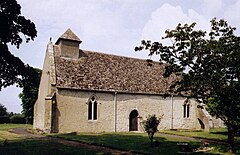Baulking
| Baulking | |
|---|---|
 St. Nicholas' parish church |
|
| Baulking shown within Oxfordshire | |
| Area | 6.38 km2 (2.46 sq mi) |
| Population | 107 (2011 census) |
| • Density | 17/km2 (44/sq mi) |
| OS grid reference | SU3190 |
| Civil parish |
|
| District | |
| Shire county | |
| Region | |
| Country | England |
| Sovereign state | United Kingdom |
| Post town | Faringdon |
| Postcode district | SN7 |
| Dialling code | 01367 |
| Police | Thames Valley |
| Fire | Oxfordshire |
| Ambulance | South Central |
| EU Parliament | South East England |
| UK Parliament | |
Baulking or Balking is a village and civil parish about 3.5 miles (5.6 km) southeast of Faringdon in the Vale of White Horse district of Oxfordshire. It was part of Berkshire until the 1974 Boundary Changes transferred it to Oxfordshire.
The parish is bounded to the north and north-west by the River Ock, to the south by its tributary Stutfield Brook and to the east by field boundaries. The village is arranged along a large, elongated village green running north–south, on the side of a slight rise of land bounded on two sides by a bend in the river.
Balking is an ancient form of the toponym, dating from the 10th century. Other forms from the same century were Bedelacing and Bedelakinges. 12th-century forms included Badeleking and Badeking. Further forms were Batheleking in the 13th century, Bauking in the 16th century and Bawlkin in the 17th century.
In AD 948 King Eadred gave five hides of land at Baulking to his servant Cuthred, and it was said that Cuthred gave the land to the Benedictine Abingdon Abbey. By 1187 the manor had passed to the lords of Kingston Lisle, with whom it remained until the 20th century.
The Grade-I-listedChurch of England parish church of Saint Nicholas was built at the beginning of the 13th century as a dependent chapel of Uffington. The chancel has Early English Gothic lancet windows. In the 14th century diagonal buttresses were added to the church and two Decorated Gothic windows were added in the south wall of the nave. The Perpendicular Gothic window in the north wall of the nave was added late in the 15th century. The oak pulpit is Jacobean and came from Grittleton in Wiltshire. The nave roof is also Jacobean. St. Nicholas' Communion plate includes a chalice made in 1583.
...
Wikipedia

